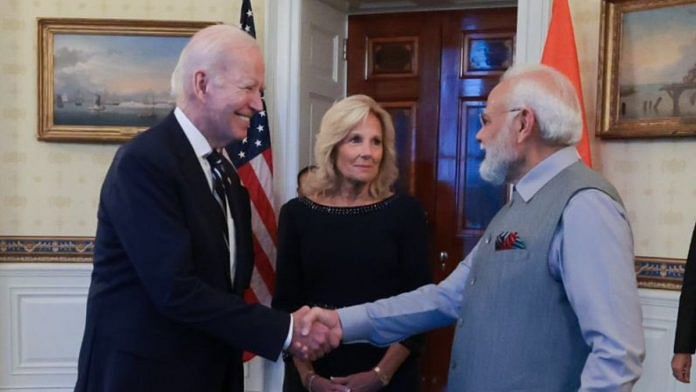For the first time in a long time—perhaps for the first time ever—an Indian prime minister is receiving blanket coverage across American television, print, and digital media. Though pockets of scepticism can be found, the keynote tone is excitement. For good or (occasionally) for bad, everyone wants to talk India. It feels like the Amrit Kaal of US-India relations is here.
Few Americans would have any idea what “Amrit Kaal” means, or what it has to do with India. But they do know that this is India’s moment, that India is the new China for America’s corporate leaders, and that there is bipartisan support for India on Capitol Hill. And for the first time, most Americans can probably name one Indian other than Mahatma Gandhi. That Indian’s name is Narendra Modi.
The turnaround
The new excitement represents a fast turnaround in the direction of US-India relations. In 2021, Biden’s nominated ambassador to India, Eric Garcetti, vowed to make NGO concerns about Muslim rights a “core piece” of his mission. Then in 2022, the Biden administration started pressuring India to publicly condemn its longest-standing arms supplier—and only reliable veto on the UN Security Council.
When the highly politicised United States Commission on International Religious Freedom (USCIRF) made its annual appeal for the State Department to name India a “country of particular concern” for religious repression, Biden’s own ambassador-at-large for international religious freedom Rashad Hussain pointedly accused Indian government “officials” of “supporting rising attacks on people and places of worship”.
It was an overt attempt to sabotage the administration’s India policy, and an act of desperation. Hussain even prefaced his allegation with “as the Secretary stated”. Although Secretary of States Antony Blinken had stated no such thing. That was in mid-2022. When the 2023 USCIRF report was released, Hussain was not invited back to the podium.
Instead, President Biden invited PM Narendra Modi to Washington for an official State visit. Not to be outdone, the United States Congress issued its own invitation to Modi to address a joint session of the Senate and the House of Representatives. The joint session is symbolic, because support for India is one of the few things the Democrat-controlled House and the Republican-controlled Senate agree on. In America, India is now bipartisan.
If there ever was an Amrit Kaal for US-India relations, it is now. It’s not just that India’s corporate and diaspora boosters are out in force. Even India’s staunchest critics in America have been marginalised as never before.
The few US news outlets that want to highlight criticisms of India have had to turn to Minnesota Representative Ilhan Omar, who can be counted on to tell anyone who will listen that India is primed for a Muslim genocide.
For everyone else, it’s pure celebration. Fans of Modi are focusing on “dynamic diaspora” and “world’s largest democracy” rhetoric. Detractors of Modi are focusing on India’s “youthful demographics” and the world’s “fastest-growing large economy”. Both alike share a positive vision for India—and US-India relations.
Inevitably, China forms part of that narrative, but a surprisingly small part. American geopolitical analysts have long fantasised about India opening some kind of second front to relieve Chinese maritime pressure in the Western Pacific, but they don’t seem to realise that India has confronted an expansionist China for more than sixty years.
It is India, not the United States, that has banned Chinese apps, provoked China to boycott the G20, and actually inflicted casualties on Chinese troops straying too far across the Line of Actual Control. Even India’s Russian-built S-400 air defence missile system, to which the United States has objected so strenuously, is intended primarily for use against China.
Also read: US is rolling out the red carpet for Modi. But White House knows Indian PM is his own man
The power of Indian-Americans
So, forget about all the defence procurement stories percolating through the war-obsessed internet. The real India excitement in the United States comes from the diaspora community and the corporate community. And with so many Indian-origin people running major US companies, the two can sometimes seem to be the same thing.
When Americans want to know about India, and especially when corporate America wants to know about India, they turn to the Indians in their midst. Indian-Americans are by far the highest-earning minority group in the United States. Everyone knows that Google, Microsoft, and IBM are all run by Indian-Americans, but they are only the tip of a very deep iceberg. At most top US companies and the professional services companies that cater to them, India-born executives can be found at every level of management.
Many of them emigrated thirty or forty years ago, and they are keenly aware of the economic changes that have occurred in India since they left. Whatever their politics, they are in no doubt that today’s India is a land of opportunity. Few of them would have thought that about the India of their formative years in the 1980s and 1990s.
Thus US-India relations, once the preserve of security analysts and human rights organisations, has become the domain of the diaspora professional. This civilianisation of the relationship bodes well for the future. Politics are inherently unpredictable, but economic networks are much more robust. The more US-India relations are driven by people, not politics, the more stable they will become.
“Amrit Kaal” is a slogan made in India, for India. It is not going to jump the cultural divide, like yoga, meditation, or ayurvedic medicine. But it is real all the same. Indian-Americans don’t have to explain the concept to their corporate colleagues in order to put it into practice. All they have to do is be themselves, and their colleagues will get the message that now is the time to go all in on India.
Salvatore Babones is an associate professor at the University of Sydney and the executive director of the Indian Century Roundtable. Views are personal.
This article is sponsored by the Motwani Jadeja Foundation.



